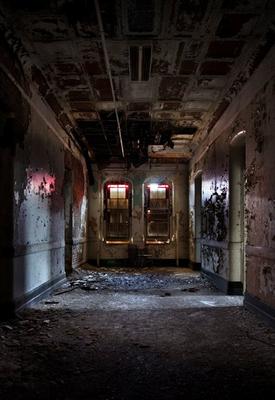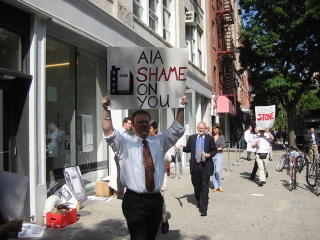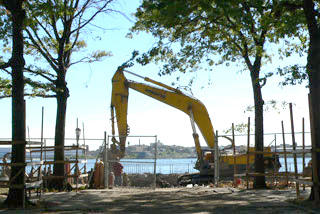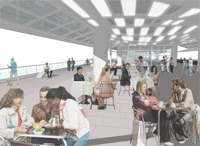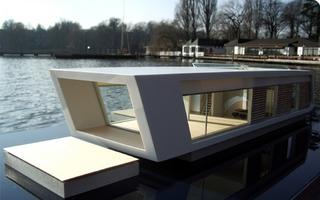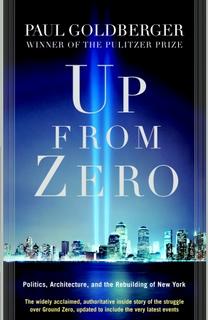
I just finished reading the updated paperback version of Paul Goldberger’s book
Up From Zero: Politics, Architecture, and the Rebuilding of New York. Anyone remotely interested in understanding what has transpired there should read this book. Even though I’ve followed the events fairly closely, Goldberger’s running account not only reminded me of things I had lost track of, but provided invaluable insight into the conflicts, bad decisions and miscommunications that have plagued the rebuilding effort. As he concluded the hardcover version of the book, “Idealism met cynicism at Ground Zero, and so far they have battled to a draw.”
The book reminded me of how much hope there was at the beginning of the rebuilding process, and how that has been so shamelessly squandered. He quotes the initial “Vision Statement” of The Civic Alliance, organized by the Regional Plan Association, which said in part:
Lower Manhattan [can] show the way to a new urban future.
Is there anyone who can say with a straight face that we’re on the way to making that hopeful statement happen?
I had a post on Polis not too long ago pleading to re“think” the WTC rebuilding site, with a reference to Rafael Vinoly’s THINK team design of two open-lattice towers that mimic the Twin Towers. Governor George Pataki, who no one would argue is an architectural visionary, single-handedly nixed the THINK team’s striking proposal based on a gut reaction, which just goes to show how powerful even a rendering can be. It succeeds precisely because it is disturbing as a symbol of what was lost as well as how we will recover: Tall and proud yet never quite the same again. Goldberger's description of Pataki's reaction reminded me of the knee-jerk response to Maya Lin’s Vietnam Memorial, which surely never would have been built if the decision were up to one politician concerned about getting re-elected.
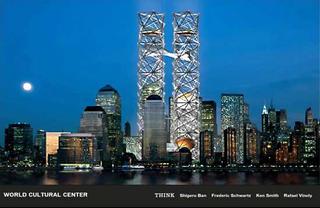
The Freedom Tower design – first proposed by Daniel Libeskind, the winner of the master plan competition, and then redrawn by David Childs of Skidmore Owings and Merrill – is an unqualified, abject failure. It is neither a good commercial office building, nor does it work as a symbol. It could be a skyscraper in Anywhere, USA, minus the bunker-like base to satisfy security concerns that can never be fully addressed unless we build a nuclear bomb shelter at Ground Zero and leave it at that.
As if there weren’t enough evidence that irony is most certainly not dead, as was claimed shortly after 9/11, the most recent disheartening development at Ground Zero is the demise of the International Freedom Center. It was nixed because people are scared of too much free speech taking place through exhibits that say something about oppression around the world. Maybe it was naive to think any real culture could thrive in such an atmosphere, but it’s another disappointment just the same.
What really needs to happen is this: Mayor Bloomberg needs to take the reins of the rebuilding effort. Period. With Pataki on the way out and the West Side Stadium dead in the water -- and Bloomberg’s re-election all but assured -- now is the time to start laying the groundwork for taking back this process for the people of New York.
Mayor Bloomberg could instruct Daniel Doctoroff to revive his brilliant idea to swap the land under the airports (which is owned by the city, even though the airports are run by the Port Authority), in exchange for taking control of the WTC site, which is owned by the Port Authority and leased to developer Larry Silverstein. There are clearly too many cooks in the kitchen with too many conflicting interests. The Port Authority and Larry Silverstein are insisting on maximizing profits from commercial and retail on the site, with everything else an afterthought.
If the land swap fails, then Bloomberg should go to the state when Pataki is out of office and ask that the state condemn the land for public use. As Goldberger points out in Up From Zero:
… as the events of September 11 were unprecedented in American history, so, too, should the response have been unprecedented. After all that happened in the aftermath of the terrorist attacks and the destruction of the most powerful symbol of the American skyline, it is hard to believe that the public would have objected to the decision to take over these sixteen acres of land for public purpose, and to use public funds to purchase the land from the Port Authority or to buy out Silverstein’s lease.
Mayor Bloomberg has a golden opportunity to create a lasting legacy far more meaningful than a football stadium. And the plans he announced two years ago to revitalize
Lower Manhattan around the WTC site show that he has the right instincts about what needs to happen at the site itself, which is to create a lively neighborhood that also respects the lives that were lost there. With sixteen acres to work with, this is entirely doable, so long as absurdly unnecessary office and retail space isn’t forced into what has the potential to become the most inspiring rebuilding effort the world has ever seen.
 I'm temporarily breaking my fast here on P0lis (see below) to note an article in the Times about floating architecture, which I've already posted about a couple of times. I was also at the inaugural gathering of the Forum for Urban Design last night, hosted by Paul Goldberger, which was a discussion about rebuilding New Orleans, and amphibious housing came up there, too. (The Forum is so new it doesn't have a website yet, but I'll link to it when its up.) Anyway, this amphibious neighborhood idea is obviously getting some traction.
I'm temporarily breaking my fast here on P0lis (see below) to note an article in the Times about floating architecture, which I've already posted about a couple of times. I was also at the inaugural gathering of the Forum for Urban Design last night, hosted by Paul Goldberger, which was a discussion about rebuilding New Orleans, and amphibious housing came up there, too. (The Forum is so new it doesn't have a website yet, but I'll link to it when its up.) Anyway, this amphibious neighborhood idea is obviously getting some traction.









